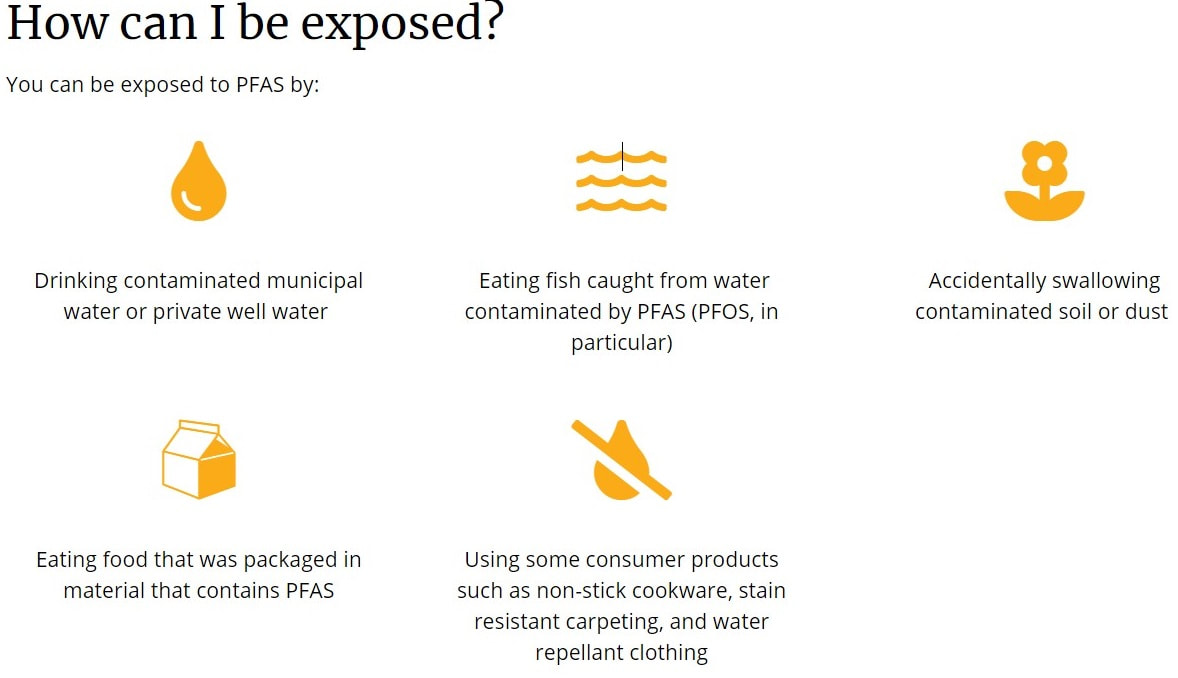|
Known as “forever chemicals”, per- and polyfluoroalkyl substances (PFAS) are a group of chemicals with strong carbon-fluoride bonds that persist in the environment. They bioaccumulate in the human body over time due to more PFAS being absorbed than excreted. PFAS can be found in materials that have water-, grease- and stain- repellent properties. According to the US Agency for Toxic Substances and Disease Registry, common routes of exposure to PFAS include: 1) drinking contaminated municipal water or private well water, 2) eating fish caught from water contaminated by PFAS, 3) accidentally swallowing contaminated soil or dust, 4) eating food that was packaged in materials that contain PFAS, and 5) using consumer products such as non-stick cookware, stain resistant carpeting, and water repellant clothing (Figure 1). Figure 1: Routes of PFAS exposure (Source: US Agency for Toxic Substances and Disease Registry Higher PFAS level in blood is associated with higher total cholesterol, higher triglycerides, and lower low-density lipoprotein (LDL, known as the good cholesterol). Higher PFAS exposure has also been linked with liver damage, immunotoxicity, decreased fertility, thyroid disease, obesity, hormone disruption, and cancer. PFAS were first manufactured in the US in the 1940s. Due to their preferable properties for industrial application, PFAS were widely used in consumers goods, e.g. non-stick coatings, stain and water-resistant products, firefighting foams, waterproof fabrics, etc. Nearly everyone in the US has used products made with PFAS and have PFAS in their blood due to this exposure. The US Environmental Protection Agency (EPA) first noted the health risks from PFAS in 1998, leading the US Centers for Disease Control and Preventions (CDC) to implement a biomonitoring program of PFAS in the US population. [Watch the feature film, Dark Waters (2019) to learn more about the story of how PFAS contamination and health hazards were exposed]. In 2000, major PFAS manufacturers in the US began voluntary phase-outs of legacy PFAS. Perfluorooctane sulfonic acid (PFOS), the most widely used PFAS, ceased production in the US by 2002; Perfluorooctanoic acid (PFOA) ceased production in the US by 2015. To better understand the temporal trends and changes in PFAS concentrations across the US population, our research team obtained permission to analyze six of the most common PFAS in blood samples collected from participants of the Diabetes Prevent Program from 1996 to 2012. We compared our findings with biomonitoring data from the CDC. Overall, we observed that the phase-out of PFOS and PFOA was associated with downward trends of mean PFOS and PFOA concentrations in the US population, though at a slow rate of decline . Since 2000, the mean concentration of PFOS reduced by half after 7.23 years, and the mean concentration of PFOA reduced by half after 10.19 years among adults with overweight/obesity. We also noted an increase in perfluorononanoic acid (PFNA) concentration from 2000 to 2010, which was likely due to the increase in PFNA production to replace PFOS and PFOA. When evaluating across participants’ characteristics, we consistently observed higher PFOS and PFNA in males compared to females, which was likely due to differences in PFAS excretion mechanism between sexes. More specifically, females can excrete PFAS via breastfeeding and menstruation. We also observed PFAS exposure disparity across race/ethnicity. Previous data (1999-2008) from the CDC showed that Mexican Americans had lower measured levels of PFOS and PFNA compared to non-Hispanic White and non-Hispanic Black individuals. In our study, we found that African American and Black participants had higher mean PFOS and PFNA concentrations compared to White participants. Since we did not observe a significant difference in rates of PFAS elimination half-lives, the racial disparity in PFAS concentration in the blood likely reflected differences in exposure patterns such as diet and lifestyle, historical exposures, residential location, and social determinants. While it is promising to know that concentrations of PFOS and PFOA in the US population have declined since 2000 due to national policies, industrial compliance, and stewardship efforts, many replacement PFAS are continuously being made to meet industrial demands. Continuous surveillance of PFAS exposure is critical for understanding the long-term impact of PFAS on population health.
0 Comments
Your comment will be posted after it is approved.
Leave a Reply. |
©2017 WeighingInBlog. All rights reserved. 401 Park Drive, Boston, MA





 RSS Feed
RSS Feed

